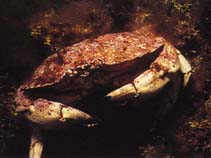Cancer borealis Stimpson, 1859
Jonah crab| Native range | All suitable habitat | Point map | Year 2050 |

|
| This map was computer-generated and has not yet been reviewed. |
| Cancer borealis AquaMaps Data sources: GBIF OBIS |
Classification / Names Κοινά ονόματα | Συνώνυμα | CoL | ITIS | WoRMS
Malacostraca | Decapoda | Cancridae
Environment: milieu / climate zone / εύρος βάθους / distribution range Οικολογία
; εύρος βάθους 0 - 800 m (Αναφ. 367). Subtropical, preferred 11°C (Αναφ. 107945); 59°N - 20°N, 85°W - 52°W
Distribution Χώρες | Περιοχές FAO | Οικοσυστήματα | Παρουσίες | Εισαγωγές
Western Atlantic: from Newfoundland and Labrador, Canada to Dry Tortugas, Florida and Cuba.
Length at first maturity / Μέγεθος / Weight / Age
Γεννητική Ωρίμανση: Lm 8.8 range ? - ? cm Max length : 16.0 cm CW αρσενικό/απροσδιόριστο; (Αναφ. 101412); μεγ. δημοσιευμένο βάρος: 0.00 g
Short description Μορφολογία
Carapace approximately 2/3 as long as wide, surface coarsely granulate; front (excluding inner orbital angles) with 3 teeth, middle one exceeding others and depressed (flattened dorsoventrally); anterolateral margins divided into 9 quadrangular lobes or teeth with margins minutely denticulate; notches between teeth continued on carapace as short, closed fissures. Pincers stout, nearly as long as second legs, carpus and hand with strong granulose rugae, upper margin of pincers denticulate, carpus with sharp inner dorsal spine. Color: red dorsally, yellow ventrally; back with 2 curved lines of yellowish spots and behind middle, a figure somewhat resembling letter H; legs mottled and reticulated with yellow and red, more or less purplish.
Minimum depth from Ref. 97531. Lives in deep water (Ref. 106868). Occurs from the intertidal zone among rocks to 800 m (Ref. 367). Common in shallow subtidal zone during summer (Ref. 106868). Small to medium-sized individuals are found near shore seasonally (especially in the south), while larger ones only occur in deeper water (Ref. 367). Moves from subtidal into low intertidal with the tide (Ref. 106868). Found in rocky bottom in association with Homarus americanus. Also on rubble and soft substrate (Ref. 97531). Feeds mainly on mollusks, echinoderms, and other invertebrates (Ref. 367). Preyed upon by gulls (Ref. 106868).
Life cycle and mating behavior Γεννητική Ωρίμανση | Αναπαραγωγή | Γεννοβολία | Eggs | Γονιμότητα | Larvae
Members of the order Decapoda are mostly gonochoric. Mating behavior: Precopulatory courtship ritual is common (through olfactory and tactile cues); usually indirect sperm transfer.
Main reference
Αναφορές | Συντονιστής | Συνεργάτες
Tavares, M. 2003. (Αναφ. 367)
IUCN Red List Status
(Αναφ. 130435: Version 2024-2)
CITES status (Αναφ. 108899)
Not Evaluated
CMS (Αναφ. 116361)
Not Evaluated
Threat to humans
Human uses
αλιεία: Εμπορικό(ά)
FAO - αλιεία: landings | FishSource | Η θάλασσα γύρω μας
Εργαλεία
Περισσότερες πληροφορίες
Τροφική Οικολογία
Οικολογία
Population dynamics
Αύξηση
Max. ages / sizes
Length-weight rel.
Length-length rel.
Length-frequencies
Mass conversion
Στρατολόγηση
Αφθονία
Max. ages / sizes
Length-weight rel.
Length-length rel.
Length-frequencies
Mass conversion
Στρατολόγηση
Αφθονία
Life cycle
Distribution
Human Related
Aquaculture profiles
Stamps, coins, misc.
Stamps, coins, misc.
Outreach
Αναφορές
Διαδικτυακές πηγές
BHL | BOLD Systems | CISTI | DiscoverLife | FAO(αλιεία: ; publication : search) | Fishipedia | GenBank (genome, nucleotide) | GloBI | Gomexsi | Google Books | Google Scholar | Google | PubMed | Δέντρο Ζωής | Wikipedia (Go, αναζήτηση) | Zoological Record
Estimates based on models
Preferred temperature
(Ref. 115969): 1.6 - 17.9, mean 6.4 (based on 149 cells).
Nutrients : Calcium = 109 [35, 184] mg/100g; Iron = 1.59 [1.21, 1.97] mg/100g; Protein = 20.2 [19.2, 21.3] %; Omega3 = 0.285 [0.185, 0.386] g/100g; Selenium = 48.3 [-31.7, 128.3] μg/100g; VitaminA = 0 μg/100g; Zinc = 1.79 [1.17, 2.40] mg/100g (wet weight); based on nutrient studies.



